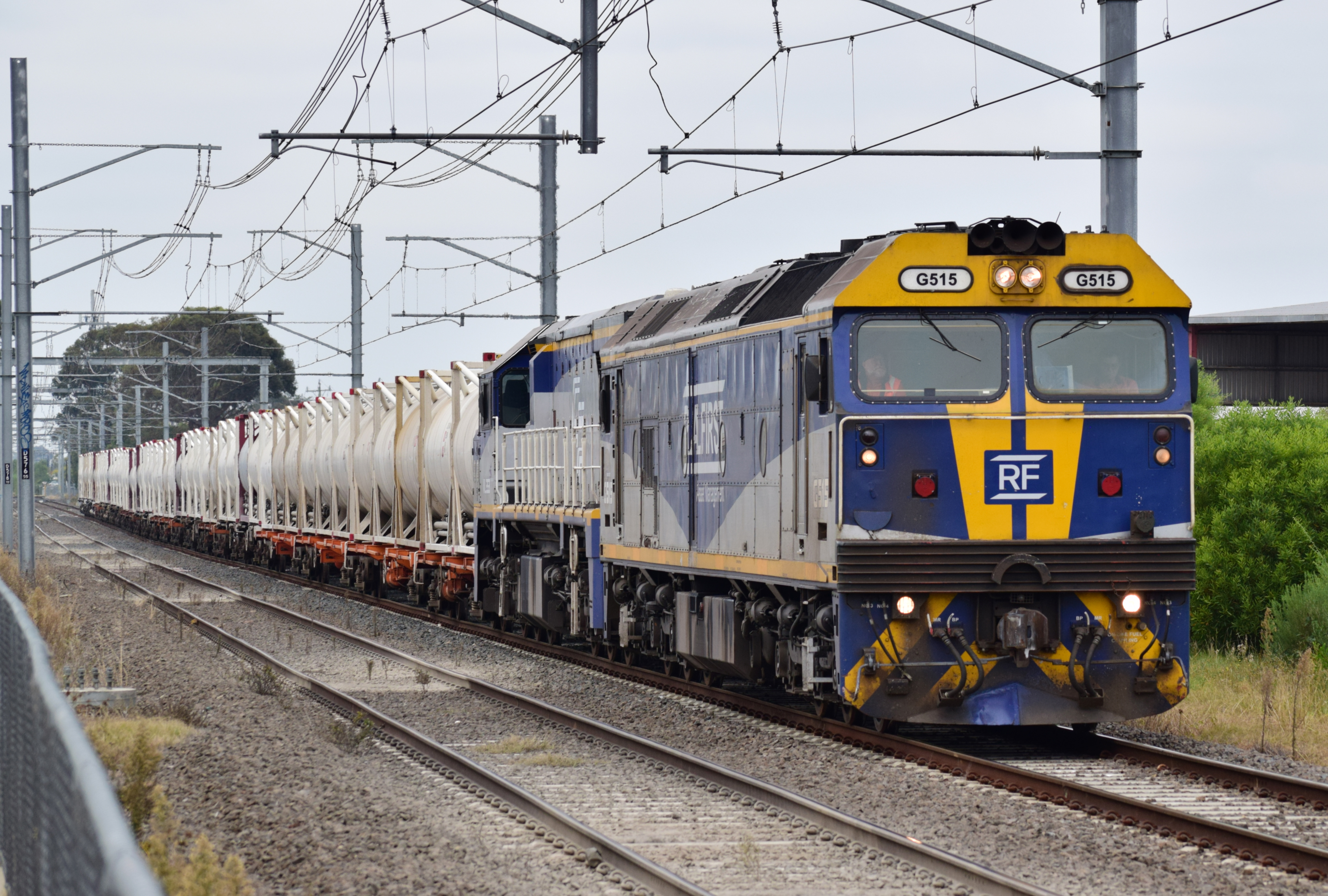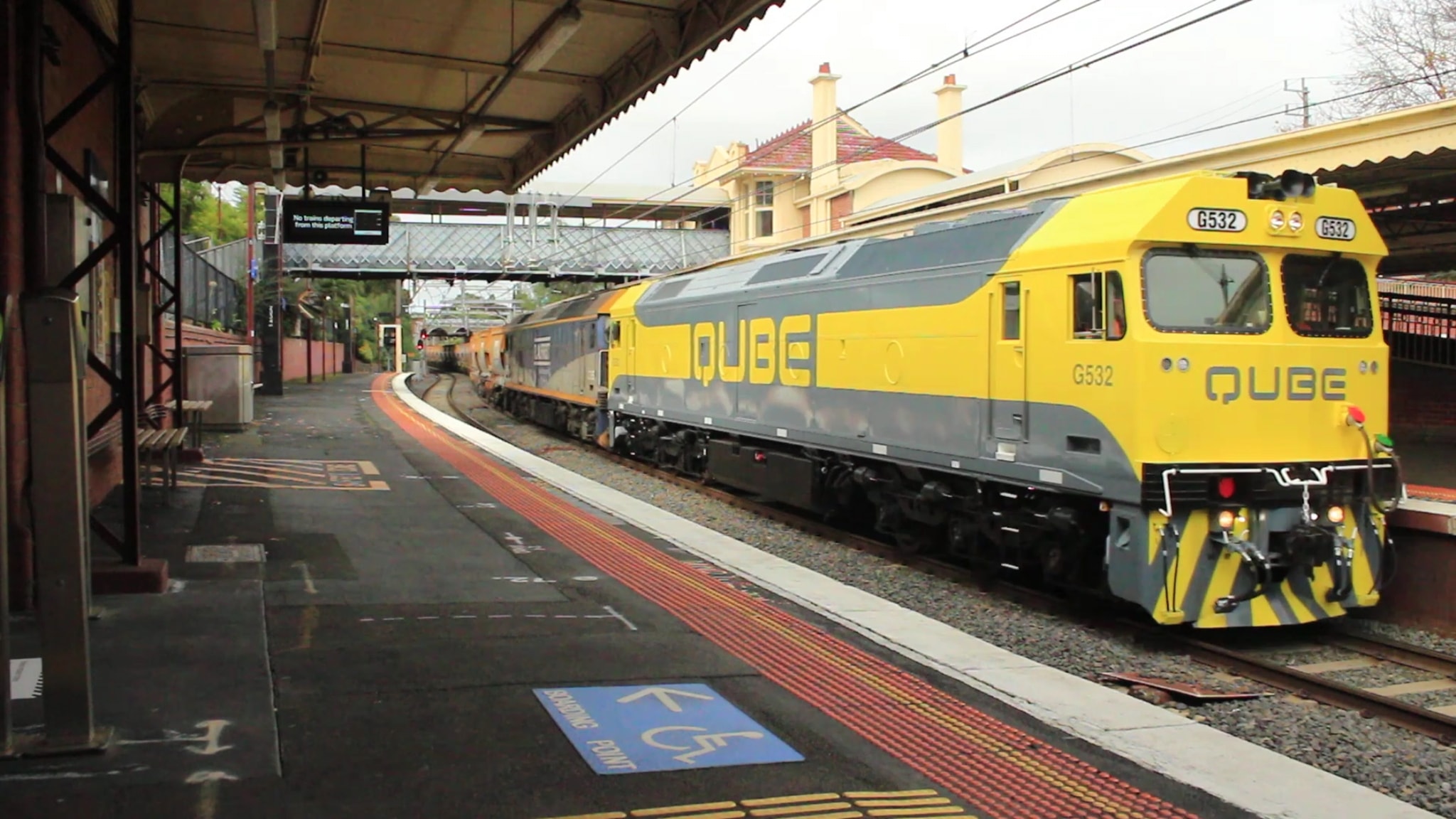V/Line G class (diesel) on:
[Wikipedia]
[Google]
[Amazon]

 The G Class are a class of diesel locomotive built by
The G Class are a class of diesel locomotive built by
Vicsig A second order was placed for ten further units that were more tailored to V/Line's requirements. The first five were built with standard gauge bogies being delivered via Sydney. Over the next few years, members of the second batch would frequently swap gauges as needs dictated. In July 1986, through running without changing locomotives at
Going Loco: Track Test of V/Line loco G517
{{DEFAULTSORT:V Line G Clyde Engineering locomotives Co-Co locomotives Pacific National diesel locomotives Railway locomotives introduced in 1984 Standard gauge locomotives of Australia Aurizon diesel locomotives Victorian Railways diesel locomotives, G class Broad gauge locomotives in Australia Diesel-electric locomotives of Australia

 The G Class are a class of diesel locomotive built by
The G Class are a class of diesel locomotive built by Clyde Engineering
Clyde Engineering was an Australian manufacturer of locomotives, rolling stock, and other industrial products.
It was founded in September 1898 by a syndicate of Sydney businessmen buying the Granville factory of timber merchants Huds ...
, Rosewater and Somerton Somerton may refer to:
Places Australia
* Somerton, New South Wales
* Somerton Park, South Australia, a seaside Adelaide suburb
** Somerton Man, unsolved case of an unidentified man found dead in 1948 on the Somerton Park beach
* Somerton, Victoria ...
for V/Line
V/Line is a statutory authority that operates regional passenger train and coach services in Victoria, Australia. It provides passenger train services on five commuter lines and eight long-distance routes from its major hub at Southern Cros ...
between 1984 and 1989.
History
By the early 1980s, the first generation diesels purchased by theVictorian Railways
The Victorian Railways (VR), trading from 1974 as VicRail, was the state-owned operator of most rail transport in the Australian state of Victoria from 1859 to 1983. The first railways in Victoria were private companies, but when these companie ...
were nearly 30 years old, with an average fleet age of 20 years. In addition, 70% of the fleet was of 1,000 horsepower or less, a consequence of the historically large number of branch lines in the state.
Rationalisation of the rail freight task had also been carried out, with small freight consignments being consolidated to 'freight centres' from 1976. Moves had also been made towards the operation of block trains
A unit train, also called a block train or a trainload service, is a train in which all cars (wagons) carry the same commodity and are shipped from the same origin to the same destination, without being split up or stored en route.
They are disti ...
carrying a single commodity, rather than trains carrying a wider variety of freight. Grain became the major commodity carried by rail in Victoria, with the consulting arm of Canadian National
The Canadian National Railway Company (french: Compagnie des chemins de fer nationaux du Canada) is a Canadian Class I freight railway headquartered in Montreal, Quebec, which serves Canada and the Midwestern and Southern United States.
CN ...
commissioned by VicRail in 1983 to find ways of improving efficiency. Recommendations carried out included increasing train sizes to 50 bogie wagons and closing a number of branch lines.
Delivery
At the same time Australian National had placed an order withClyde Engineering
Clyde Engineering was an Australian manufacturer of locomotives, rolling stock, and other industrial products.
It was founded in September 1898 by a syndicate of Sydney businessmen buying the Granville factory of timber merchants Huds ...
, Rosewater for 10 BL class locomotives, with an option for a further five. VicRail's chairman Alan Reiher, stepped in and negotiated for the five to be completed for the newly formed V/Line
V/Line is a statutory authority that operates regional passenger train and coach services in Victoria, Australia. It provides passenger train services on five commuter lines and eight long-distance routes from its major hub at Southern Cros ...
. The new diesels had a much higher axle load
An axle or axletree is a central shaft for a rotating wheel or gear. On wheeled vehicles, the axle may be fixed to the wheels, rotating with them, or fixed to the vehicle, with the wheels rotating around the axle. In the former case, bearin ...
than the smaller T and Y class diesels used on branch lines, with these lines either being upgraded to carry heavier trains or closed. These were all delivered in late 1984.G ClassVicsig A second order was placed for ten further units that were more tailored to V/Line's requirements. The first five were built with standard gauge bogies being delivered via Sydney. Over the next few years, members of the second batch would frequently swap gauges as needs dictated. In July 1986, through running without changing locomotives at
Albury
Albury () is a major regional city in New South Wales, Australia. It is located on the Hume Highway and the northern side of the Murray River. Albury is the seat of local government for the council area which also bears the city's name – the ...
began with G class locomotives operating through to Sydney. Two further contracts for eleven and seven broad gauge units had brought the fleet up to 33 by November 1989. The first 15 were built at Clyde Engineering's, Rosewater factory with the balance built at Somerton Somerton may refer to:
Places Australia
* Somerton, New South Wales
* Somerton Park, South Australia, a seaside Adelaide suburb
** Somerton Man, unsolved case of an unidentified man found dead in 1948 on the Somerton Park beach
* Somerton, Victoria ...
.
Although primarily intended for hauling freight services, they were also used on passenger trains such as the ''Intercapital Daylight
The Inter-Capital Daylight was a passenger train that operated between Australia's two largest cities, Sydney and Melbourne from March 1956 until August 1991.
History
Until April 1962, the line between Sydney and Albury was of a different gau ...
'' and '' Sydney/Melbourne Express''. They rarely hauled broad gauge passenger trains."The G class locomotives of Victoria" ''Railway Digest'' April 2000 page 23
National Rail
WhenNational Rail
National Rail (NR) is the trading name licensed for use by the Rail Delivery Group, an unincorporated association whose membership consists of the passenger train operating companies (TOCs) of England, Scotland, and Wales. The TOCs run the ...
commenced operating interstate services in the mid 1990s, seven (517–520, 522, 523 & 525) were leased by V/Line pending the delivery of the NR class
The NR class are a class of Australian diesel locomotive built by A Goninan & Co for National Rail between 1996 and 1998. They are currently operated by Pacific National. The C44aci model locomotives built by UGL Rail at Broadmeadow adopted ...
.
The class were also used on the first privately operated train on government tracks in Australia, operated by SCT Logistics with V/Line locomotives and crews between Melbourne and Adelaide on 13 July 1995. This was extended through to Perth from October 2000.
Freight Australia
All 31 were included in the sale of V/Line Freight to Freight Australia, Freight Victoria in March 1999. On 26 November 1999, G517 and G518 were destroyed in a head-on collision at Ararat railway station, Victoria, Ararat when an eastbound grain train collided with a stationary ballast train at 70 km/h. Freight Australia commenced a program of engine upgrades purchasing new, more powerful EMD 645, EMD 16-645F3B engines for some of the G class, with the old engines being used to repower Victorian Railways X class (diesel), X class locomotives, later recoded the Freight Australia XR class, XR class. The upgraded G classes were G523, G526, G529, G530, G531, G536, G541 and G543. These locos now have a power output of 3,800hp (2795kW). In the early 2000s, Freight Australia was contracted to move freight between Melbourne and Sydney for CRT Group. The contract contained a clause that if Freight Australia was acquired by a competitor of CRT Group, of locomotive power (calculated by the business CRT Group was offering Freight Australia) was to be transferred to CRT Group. As a result, when Freight Australia was acquired by Pacific National in 2004, G516 & G534 were handed over to QR National along with X53 & X54. A condition imposed by the Australian Competition & Consumer Commission on Toll Group, Toll Holdings taking control of Pacific National was that nine locomotives be sold to SCT Logistics. This resulted in nine G class passing to SCT Logistics in February 2007. By mid 2008, SCT Logistics had received new locomotives, and their G classes were sold to the AWB Limited, Australian Wheat Board, Rail First Asset Management, CFCLA and Southern Shorthaul Railroad. Pacific National's fleet operate on both the broad and standard gauges, with the latter often operating in New South Wales.Features
The G class featured imported General Motors-Electro-Motive Division technology (prime mover, alternator and traction motors) on a locally designed frame and body. Major advances introduced with the class included cab air conditioning, onboard toilet, ''Trimount'' type high adhesion bogies, and ''Super Series'' wheel creep control to enable heavier loads to be hauled. The locomotives were designed to be of minimum mass, allowing a higher fuel load. The body consists of two side trusses with load bearing supports, roofbows and integral cabs. The side panels are made of fibreglass for the minimum weight, with various accessories mounted in removable roof hatches. The first five units were fitted with carbody pressurisation, as fitted to many other Australian National locomotives for operation in the dusty outback areas they operated in. Differences in the subsequent units included the fitting of double blade windscreen wipers, lowering of the multiple-unit jumper receptacle, and the changing of the marker light orientation from vertical to horizontal. Recent years have seen many of the class fitted with on line refuelling, and working from Melbourne to Perth on the SCT Logistics service.Fleet list
* G511-515 were originally built as BL36-40. * G543 was built with (and still has) a desktop cab layout, being a test bed for the DL and AN class locomotives.Model railways
HO Scale
Auscision Models has announced a future project including G Class Mark 1 locomotives – G511, 512 in early V/Line orange/grey and Freight Australia green/yellow (and 512 only in Chicago Freight Car Leasing Australia blue/grey), 513 and 514 in late V/Line orange/grey, Specialised Container Transport red/white and Southern Shorthaul Railroad yellow/black, 515 in Freight Victoria green/yellow and in Chicago Freight Car Leasing Australia blue/grey. The models are expected to be delivered either as DC, or for an additional charge they could be pre-fitted with DCC and Sound. Austrains in 2014 released models of the G class locomotive retailing at about $300 per model, and originally intended to include the option of pre-fitted DCC and Sound for an additional $100.. The range included "G 220" in VR Blue and Gold, using the body shell of a Series 1 type; in V/Line the locomotives included G 511, 518, 523 and 531. Freight Australia locomotives included G 513, 521 and 539, and the Pacific National models include 532, 535 and 540. Powerline released models of the first two batches of G class locomotives in V/Line Orange in 1989, then with a new motor type in 1997. The first run included G 513, 515, 521 and 523 with a single motor, and 512, 514, 522 and 524. The second run had G 511, 513 with single motors and 512 with dual motors.References
External links
* * Australian Road & Track Magazine, June 199Going Loco: Track Test of V/Line loco G517
{{DEFAULTSORT:V Line G Clyde Engineering locomotives Co-Co locomotives Pacific National diesel locomotives Railway locomotives introduced in 1984 Standard gauge locomotives of Australia Aurizon diesel locomotives Victorian Railways diesel locomotives, G class Broad gauge locomotives in Australia Diesel-electric locomotives of Australia